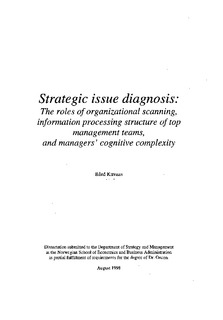| dc.description.abstract | Managers in organizations are continuously confronted by an array of ambiguous data and
-vaguely felt stimuli which they must somehow order, explicate and imbue with meaning
before they decide on how to respond. This study of -162 -members of organizations' top
management teams employed a cross-level analysis to investigate how individual-, group- and
organizational-level factors relate to how managers diagnose strategic issues. Findings show
that managers' cognitive style, the information processing structure of top management teams,
and organizational scanning, 'each are uniquely related to how managers makes sense of
environmental trends or events. Thus, contrary to previous issue interpretation research,
individual characteristics were found to be related to strategic issue diagnosis. Moreover,
different forms of organizational scanning were differently associated with managers'
sensemaking. Finally, the relationship between cognitive style and strategic issue diagnosis
was moderated by the level of organizational information processing. The discussion
addresses the implications of these findings for future research on strategic issue diagnosis. | en |
